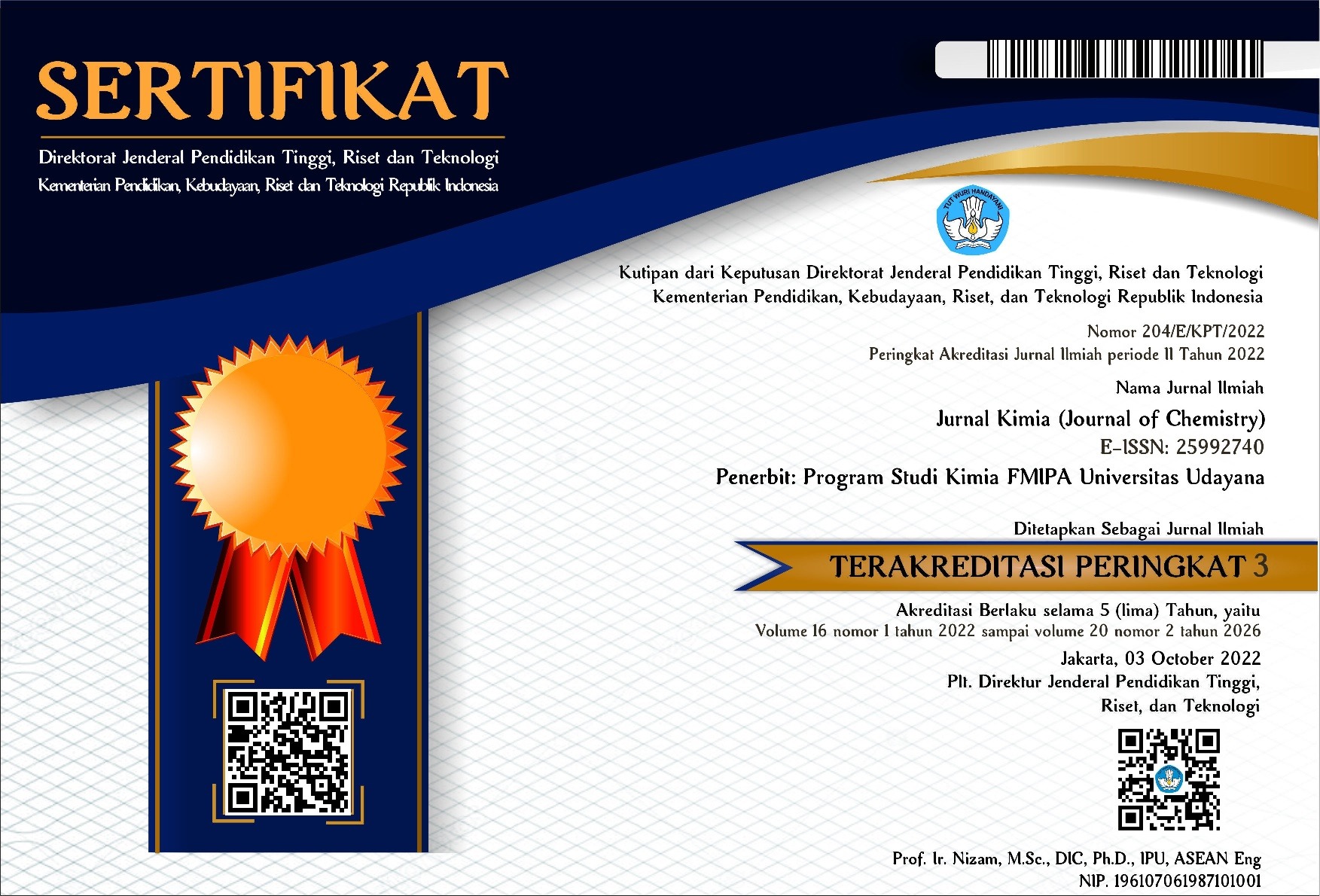SYNTHESIS AND CHARACTERIZATION OF BIVO4 AND Co-DOPED BIVO4 FILMS AS PHOTOCATALYST MATERIAL
Abstract
Bismut vanadat (BiVO4) merupakan semikonduktor tipe-n dengan energi celah pita sebesar 2,4 eV karena adanya perbedaan energi antara orbital 6s Bi3+ dan orbital 3d V5+. Energi celah pita yang sempit ini membuat BiVO4 mampu menyerap cahaya tampak, sehingga menjadikannya kandidat potensial sebagai material fotokatalis. Namun, kinerja fotokatalitik BiVO4 terbatas karena mobilitas elektron yang rendah dan laju rekombinasi pasangan elektron-lubang yang tinggi, sehingga menurunkan efektivitas fotokatalitiknya. Modifikasi material diperlukan untuk menghambat rekombinasi elektron-lubang, salah satunya melalui doping dengan kobalt (Co²?) pada permukaan BiVO4 berfungsi sebagai perangkap muatan. Dalam penelitian ini, film BiVO4 disintesis menggunakan bubuk BiVO4 yang diperoleh melalui metode hidrotermal. Asam sitrat digunakan sebagai prekursor, sementara etilen glikol digunakan sebagai binder dan pelarut. Untuk film BiVO4 terdoping Co, ion Co²? didispersikan ke permukaan film BiVO4 dengan menambahkan larutan kobalt(II) nitrat ke permukaan film yang telah disiapkan sebelumnya. Analisis pola difraksi sinar-X (XRD) menunjukkan bahwa film BiVO4 memiliki polikristalin dengan struktor monoklinik Scheelite. Selain itu, terdapat preferensi orientasi kristal pada arah <040>. Karakterisasi sifat optik menggunakan spektroskopi reflektansi difusi UV-vis menunjukkan bahwa energi celah pita (Eg) untuk transisi elektronik yang diizinkan secara langsung sebesar 2,49 eV, yang dihitung menggunakan metode Kubelka-Munk. Film BiVO4 terdoping kobalt memperlihatkan dua tepi serapan tambahan pada 2,28 eV dan 1,45 eV, yang mengindikasikan keberadaan keadaan cacat (defect states) yang berasal dari penggabungan ion kobalt pada permukaan film. Hasil penelitian ini menunjukkan bahwa sifat optik dan struktural film BiVO4 sangat dipengaruhi oleh teknik sintesis yang digunakan.
Kata Kunci: BiVO4, BiVO4 terdoping Co, sifat optik, film
ABSTRACT
Bismuth vanadate (BiVO4) is an n-type semiconductor material with a narrow energy gap of 2.4 eV, due to the difference between the energy level of the 6s orbital of Bi3+ and the 3d orbital of V5+. Its narrow band gap is suitable for photocatalytic processes in the visible light region, but the low electron mobility and high electron-hole recombination rate reduce its photocatalytic effectiveness. Modification of this material is necessary to prevent electron-hole recombination, and it can be carried out by introducing Co2+ on the surface of BiVO4 as a charge trap. In this study, BiVO4 and cobalt-doped BiVO4 films were prepared by using hydrothermally synthesized BiVO4 powder, citric acid, and ethylene glycol as precursor, binder, and solvent, respectively. For cobalt-doped BiVO4 films, Co2+ ions were added onto BiVO4 films by spreading the cobalt(II) nitrate solution on the surface of the prepared BiVO4 films. The X-ray diffraction (XRD) patterns of the films indicated that they were polycrystalline with a monoclinic scheelite crystal structure. Moreover, preferred growth along the <040> directions was observed in the films. The optical properties of the films were analyzed by UV-Vis diffuse reflectance spectroscopy. The optical energy gap (Eg) of the deposited films was estimated using the Kubelka-Munk plot, and the value was 2.49 eV for the direct allowed electronic transition. The Co-doped BiVO4 films showed two absorption edges at 2.28 and 1.45 eV, which indicated the presence of defect states originating from the cobalt incorporation on the surface. These results indicated that the properties of BiVO4 films are highly affected by the preparation technique.
Keywords: BiVO4, cobalt-doped BiVO4, optical properties, films.
Downloads
References
Noureen, A., Wang, Q., Humayun, M., Shah, W. A., Xu, Q., Wang, X. 2023. Recent advances in structural engineering of photocatalysts for environmental remediation. Environmental Research. 219:115084.
Yaghoubi, S., Mousavi, S. M., Babapoor, A., Binazadeh, M., Lai, C. W., Althomali, R. H., Rahman, M. M., Chiang, W. H. 2024. Photocatalysts for solar energy conversion: Recent advances and environmental applications. Renewable and Sustainable Energy Reviews. 200: 114538.
Akita, M., Ceroni, P., Stephenson, G. Masson. 2023. Progress in Photocatalysis for Organic Chemistry. The Journal of Organic Chemistry. 88(10): 6281-6283.
Oktariza, L. G., Sato, Y., Gofurov, S., Ozawa, K., Islam, M. M., Ikeda, S., Sakurai, T. 2024. Characterization of the electronic structure of sputter-deposited Mo-doped BiVO4 thin-film photoanodes. Japan Journal of Applied. Physics. 63: 02SP41.
Hajra, P., Kundu, S., Maity, A., Bhattacharya, C. 2019. Facile photoelectrochemical water oxidation on Co2+-adsorbed BiVO4 thin films synthesized from aqueous solutions. Chemical Engineering Journal. 374: 1221-1230.
da Silva, M. R., Dall̕ Antonia, L. H., Scalvi, L. V. A., dos Santos, D. I., Ruggiero, L. O., Urbano, A. 2012. Deposition and characterization of BiVO4 thin films and evaluation as photoanodes for methylene blue degradation. Journal of Solid-State Electrochemistry. 16: 3627.
Hernández, S., Thalluri, S. M., Sacco, A., Bensaid, S., Saracco, G., Russo, N. 2015. Photo-catalytic activity of BiVO4 thin-film electrodes for solar-driven water splitting. Applied Catalysis A: General. 504: 266-271.
Lebedev, A., Anariba, F., Li, X., Wu, P. 2020. Rational design of visible-light-sensitive Ag-BiVO4 oxides by matching redox potentials of catalyst, dyes, and reactive oxygen species towards more efficient photocatalytic degradation. Journal of Environmental Chemical Engineering. 8(3): 103748.
Huang, K. W., Li, M. H., Chen, Y. T., Wen, Z. X., Lin, C. F., Chen, P. 2024. Fast fabrication of μm-thick perovskite films by using a one-step doctor-blade coating method for direct X-ray detectors. Journal of Materials Chemistry C. 12(4): 1533-1542.
Altalhi, T., Gobouri, A.A., Al-Harbi, L. M., Refat, M. S., El-Nahass, M.M., Hassanien, A.M., Atta, A.A., Ahmed, E. M. A. 2021. Structural, diffuse reflectance spectroscopy and dielectric relaxation properties of zirconium (IV) dioxide. Journal of Materials Research and Technology. 12: 1194-1202.
Zhao, Z., Li, Z., Zou, Z. 2011. Electronic structure and optical properties of monoclinic clinobisvanite BiVO4. Physical Chemistry Chemical Physics. 13(10): 4746-4753.
Bakhtiarnia, S., Sheibani, S., Billard, A., Aubry, E., Yazdi, M. A. P. 2022. Deposition of nanoporous BiVO4 thin film photocatalyst by reactive magnetron sputtering: Effect of total pressure and substrate. Transactions of Nonferrous Metals Society of China. 32(3): 957-971.
Zhou, B., Qu, J., Zhao, X., Liu, H. 2011. Fabrication and photoelectrocatalytic properties of nanocrystalline monoclinic BiVO4 thin-film electrode. Journal of Environmental Sciences. 23(1): 151-159.

This work is licensed under a Creative Commons Attribution 4.0 International License





